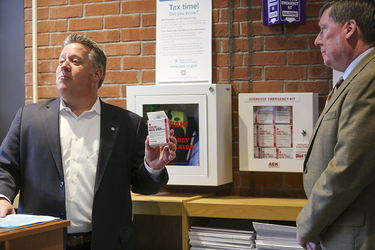Pharmacies will carry naloxone
Enterprise file photo — Michael Koff
In April, Albany County made free Narcan kits available, no questions asked, in public places, like the Guilderland library, pictured above. “If you want one of these in your building, we’ll make it happen,” said County Executive Daniel McCoy, left, at the time. Dennis Feeney, an Albany County legislator, looked on.
ALBANY COUNTY — Naloxone, known widely by the commercial brand name Narcan, is now available at pharmacies in New York state as the federal Food and Drug Administration expands access nationwide.
Naloxone can reverse the effects of a drug overdose from heroin, fentanyl, and prescription opioids.
Major pharmacies such as Walgreens, CVS, Walmart, and Rite Aid are expected to begin carrying the medication both online and in stores beginning this month, according to a Tuesday release from the governor’s office.
The drug has been available for use by non-medical personnel to prevent overdoses in New York state since 2006, and has been easier to obtain since August 2022 due to a statewide pharmacy standing order.
While it is likely that not all naloxone administrations are reported, over 35,000 naloxone administrations have been reported to the state’s health department.
Last year, 132 people died of drug overdoses in Albany County, more than triple the number since 2015.
This summer, the Centers for Disease Control and Prevention reported that there were an estimated 110,000 fatalities from drug overdoses, numbers consistent with rises in recent years.
New York state is receiving more than $2 billion through various settlement agreements with opioid manufacturers and pharmaceutical companies that were secured by Attorney General Letitia James.
A portion of the funding from settlements go directly to municipalities, with the remainder deposited into a dedicated fund to support prevention, treatment, harm reduction and recovery efforts to address the ongoing opioid epidemic, managed through the Opioid Settlement Fund Advisory Board.
In April, as Albany County placed dispensers of Narcan in public places, County Executive Daniel McCoy said that Albany County received $1.5 million this year from the state opioid settlement fund advisory board and more money is expected from the “epic fight” against Big Pharma.
The money will not go into the county’s general fund, McCoy said. Rather, a task force would decide how best to spend it for initiatives like education and prevention.
As a Narcan dispenser was placed in the Guilderland Public Library, the town’s supervisor, Peter Barber, said of opioid addiction, “This is in our community and is raging in our community.”
“Prevention is the most effective strategy,” said the county’s health commissioner, Elizabeth Whalen, of quelling the epidemic. She urged parents to talk to their children about drug use and she also spoke of the importance of keeping needed medication in “a safe spot” while disposing of unused medication.
“We really need to remove stigmatization,” said Whalen.
She noted that Stephen Giordano, the county’s commissioner of mental health, oversees the Mobile Outreach Treatment and Overdose Response team, known as MOTOR, which encourages people to get the help they need.
Such treatment, Whalen said, can change lives.
Free naloxone, as well as fentanyl and xylazine test strips, can be ordered through a new ordering portal on the Office of Addiction Services and Supports website. The agency also offers free virtual naloxone training.
New Yorkers struggling with an addiction can find help by calling the state’s toll-free, 24-hour, seven-day-a-week HOPEline at 1-877-8-HOPENY (1-877-846-7369) or by texting HOPENY (Short Code 467369).
Available addiction treatment including crisis/detox, inpatient, residential, or outpatient care can be found using the NYS OASAS Treatment Availability Dashboard at FindAddictionTreatment.ny.gov or through the NYS OASAS website.


